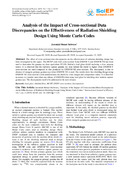| dc.contributor.author | Kebwaro, Jeremiah Monari | |
| dc.date.accessioned | 2019-10-07T07:31:05Z | |
| dc.date.available | 2019-10-07T07:31:05Z | |
| dc.date.issued | 2019 | |
| dc.identifier.citation | International Journal of Physics, 2019, Vol. 7, No. 2, 63-65 | en_US |
| dc.identifier.uri | https://karuspace.karu.ac.ke/handle/20.500.12092/2303 | |
| dc.description.abstract | The effect of cross-sectional data discrepancies on the effectiveness of radiation shielding design has
been investigated in this paper. The MCNP code with cross-sections from ENDF/B-V and ENDF/B-VII has been
used to determine the gamma ray dose equivalent, H*(10), behind a lead glass shield enclosing a slow neutron
source. It is observed that the radiative capture gamma ray dose behind the shield is higher when ENDF/B-V
cross-sections are used compared to that produced by ENDF/B-VII cross-sections. The discrepancy is due to
absence of energetic primary gamma rays when ENDF/B-VII is used. The results show that shielding design using
ENDF/B-VII cross-sections could underestimate the shield by a fair margin and compromise safety. It is therefore
necessary to consider more than one release of ENDF/B when using lead glass for shielding slow neutron capture
gamma rays. The discrepancies need to be addressed in the next releases. | en_US |
| dc.description.sponsorship | DOI:10.12691/ijp-7-2-5 | en_US |
| dc.language.iso | en | en_US |
| dc.publisher | International Journal of Physics | en_US |
| dc.subject | lead glass | en_US |
| dc.subject | shielded dose | en_US |
| dc.subject | MCNP | en_US |
| dc.subject | ENDF cross-sections | en_US |
| dc.subject | discrepancies | en_US |
| dc.title | Analysis of the Impact of Cross-sectional Data Discrepancies on the Effectiveness of Radiation Shielding Design Using Monte Carlo Codes | en_US |
| dc.type | Article | en_US |
